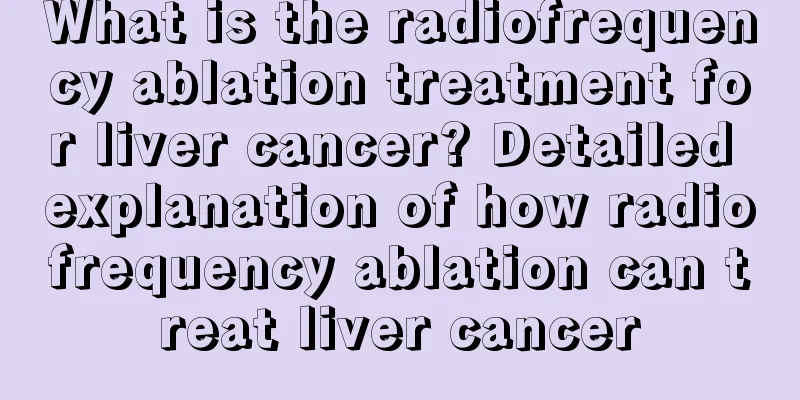What is the radiofrequency ablation treatment for liver cancer? Detailed explanation of how radiofrequency ablation can treat liver cancer

|
Primary and metastatic liver cancer is a common malignant tumor of the liver in my country. Due to its high malignancy, the prognosis is poor. Surgery and catheter interventional therapy have been widely used as effective treatment methods in clinical practice and have been accepted by physicians and patients. In recent years, percutaneous radiofrequency ablation therapy, as an emerging new treatment technology, has been gradually applied in clinical practice and has been popularized. principle: The main principle of radiofrequency ablation is that the radiofrequency electrode head emits medium- and high-frequency radiofrequency waves, which can stimulate tissue cells to produce plasma oscillations. The ions collide with each other to generate heat, reaching 80~100℃, which can effectively and quickly kill local tumor cells. At the same time, the high heat can coagulate the vascular tissue around the tumor to form a reaction zone, which prevents it from supplying blood to the tumor and helps prevent tumor metastasis. Treatment: Puncture and insert the needle under the guidance of imaging equipment such as CT, B-ultrasound, and C-arm. After the puncture is accurately positioned, radiofrequency ablation treatment is performed. The power of radiofrequency ablation is selected, generally starting from a low power of 20W, and gradually increasing the power by 10 to 20W every 1 to 2 minutes. When the tissue solidification impedance increases and the energy decreases, radiofrequency ablation will automatically stop, and a treatment can be completed. Advantages of radiofrequency ablation: ①Minimally invasive, no surgery required. ② Rapid effect and short treatment time. For diseases with a diameter of less than 5 cm, only 10 to 15 minutes of radio frequency is needed to achieve inactivation. ③ Safe and reliable. It can kill tumor tissue reliably and cause little damage to surrounding normal tissues. Intraoperative reactions and postoperative complications: During the intraoperative treatment, patients will experience varying degrees of distension, pain, and heat. Some patients may experience a decrease in heart rate, which can be treated with intramuscular injection of atropine. Occasionally, breathing difficulties may occur, which can be relieved by oxygen mask administration. Postoperative complications include: ① Pain in the liver area. When the tumor is located at the edge of the liver, the pain is particularly obvious. When the tumor is located in deep tissue, pain generally does not occur. ② Fever: The patient starts to have fever on the second day after surgery, with body temperature fluctuating around 38°C and reaching a maximum of over 39°C. The body temperature usually returns to normal within a week after the application of hormones and antibiotics after surgery. The cause is absorption heat caused by tumor necrosis absorption. ③ Jaundice and ascites: Radiofrequency causes necrosis of normal liver cells around the tumor, and the impact on liver function is the main cause of jaundice and ascites. ④ Pneumothorax: Correctly selecting the needle insertion point and avoiding the costophrenic angle can prevent pneumothorax. ⑤ Gastrointestinal perforation: Patients whose tumors are close to the gastrointestinal tract or whose tumors and gastrointestinal tracts are adhered may suffer from heat damage to the intestines during treatment, or the electrode may pass through the gastrointestinal tract when the needle is opened, which may cause gastrointestinal perforation and require surgical treatment. ⑥ Bleeding: The incidence rate is 0.46%~1.6%, mostly due to coagulation dysfunction in cirrhosis Radiofrequency therapy is a safe and effective treatment for liver space-occupying lesions, and has been recognized by many doctors and patients in clinical practice at home and abroad. At the same time, combined with transcatheter embolization (TACE) therapy, it can achieve a synergistic effect. The promotion and use of this method will provide a new treatment method for liver tumor patients, especially those with hypovascular tumors, greatly improve the quality of life of liver cancer patients, prolong survival, and provide conditions for radical cure of tumors. |
Recommend
What is the reason for black and purple lips? It turns out to be related to these two causes
Under normal circumstances, people's lips are...
International Histological Classification of Gastric Cancer
The gross morphology of advanced gastric cancer v...
The difference between field snails and golden apple snails
In fact, in life, many friends do not have a clea...
How to have plastic surgery for a long face
Face length refers to the facial contour, the arc...
What does it mean to nourish the mind?
Many people don’t know much about nourishing the ...
What are the early symptoms of pancreatic cancer
Early symptoms of pancreatic cancer include abdom...
Is belly shirt or belly belt better?
Both belly shirts and belly belts have the effect...
What is the most effective medicine for intestinal spasm
Intestinal spasm is also a relatively common dise...
How to tell if there are parasites on eyelashes
The presence of parasites in the eyelashes can be...
Advanced symptoms of uterine cancer What are the treatments for uterine cancer
Uterine cancer is a series of malignant tumors th...
Edible insects in China
We will find on TV that many people often eat som...
TCM's understanding of cervical precancerous lesions
Cervical precancerous lesions refer to lesions th...
Can filtered water be drunk directly?
It is said that water is the source of life. From...
How to cook red beans and coix seed in a microwave oven
Both red beans and coix seeds have the effects of...
Symptoms of cervical cancer when sleeping at night
Cervical cancer is a common malignant tumor of th...









